
Photo: Peter Barr/ Wikimedia Commons
You’ve doubtless been there. A perfect little hollow, sheltered from the wind, tucked behind a lonely ridge, but nevertheless commanding spectacular views. Maybe an unspoilt little woodland glade, shafts of hazy light descending through breaks in the ancient canopy. A glorious corner of the world which makes you think to yourself “This would make the perfect spot to spend the night.”
Before you go any further, if you’re new to camping you might want to check our guide to essential camping equipment or have a poke about in our camping and bushcraft section.
And, before I go any further, I’d best just clear this up: wild camping is illegal in much of Britain, but not all of it. The short, easy version is as follows: in Scotland, the right of Open Access includes wild camping, as long as you stay well clear of dwellings and roads. In England and Wales (except for Dartmoor), even in the “Open Access” areas of National Parks, permission must be sought from the landowner before you can camp.
In practice, it tends to be the case that if you exercise common sense, are discreet and remote, nobody’s going to bother you.
So then, to gear! Wild camping will obviously mean carrying everything you need with you, so with everything you take, consider the weight.

Photo: John Horner/Wikimedia Commons
You’ll be needing:
- Shelter: Most likely a tent, but that’s not the end of the story.
- Sleeping bag and mat: Your bed for the night: do not underestimate the importance of a good night’s sleep!
- Food, Drink & some way of cooking it: You need fuel for your body and fuel to cook it with. We’ll check out a few different approaches.
- Clothing: General outdoor wear, naturally, but we’ll examine how to give it a wild camping slant.
- Rucksack: Simply put- big enough but not too big; comfortable to carry.
- A few choice extras to make it all more comfortable.
There’s quite a bit of info here – we’ve tried to cover most of the important stuff – but you’ll fine tune it with your own experience. Wild camping highlights just how personal the themes of comfort and contentment are. Once you’ve been out there a few times, you’ll realise what’s important to you and what isn’t!
Let’s start with shelter…
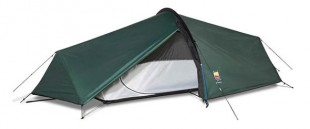
Tent
You’ll notice we said “shelter” just then. Well, by and large, this will mean a tent, but there are other options. In fact, those other options would be regarded by some as the very essence of wild camping, but we’ll come to those ideas later.
If you’re intending to wild camp, you should try to avoid brightly coloured tents. That needn’t mean obsessively searching out something with a camo-print flysheet, but if you’re trying to blend in discreetly and not be noticed, vibrant orange isn’t very sensible.
The “best” tent is the one which offers the best trade-off between comfort when you’re in it and comfort when you’re carrying it. Where that balance should be struck is different for everyone, so you’ll have to make that judgement for yourself. Bear in mind though, this is not really a luxury activity, and you’re likely to be somewhere remote…which means carrying it a fair old way. You don’t want to be cursing the weight on your back with every overloaded step you take. Most of your time inside the tent will be spent sleeping, most of the time carrying it you’ll be awake! For that reason, for the sake of being unobtrusive, and because big tents don’t fit easily into small spaces, small and light is a good bet.
If you’re likely to have a bigger group than can be accommodated in a two or three man tent, take more than one tent: a colossal barn-in-a-bag is not, as we’ve mentioned, the wild camper’s friend!
There are lots of designs of tent. Über-lightweight single-poled mountain marathon specials, through to geodesic expedition refuges which will withstand most conditions short of thermonuclear detonation. The former can be surprisingly sturdy when well pitched, and nowadays, such designs are trickling through into backpacking tents and being made with more robust materials than their adventure racing forebears. The Wild Country Zephyros, for example, is based on the design of the renowned Terra Nova Laser. There are also quirky little numbers such as the Mountain Equipment AR Ultralight, which can pitch using trekking poles rather than tent poles: much less weight to carry. Well, it is if you would have been using trekking poles anyway.

Photo: Bob Embleton/Wikimedia Commons
If you’re likely to do more than just wild camping and you’re not forking out for several tents, you’ll appreciate the versatility of the middle ground: somewhere in between the bombproof mountaineering tent and the superlight runner’s shelter. For a night or two, that balance happily tilts towards the compact and dinky. If you’re out for quite a while though, your tent will become your home and, in a tiny home, you might start feeling pretty cramped. In that case, maybe tilt the balance towards the more spacious.
Other Shelters that are not tents
If you really want to go simple, discreet and light, then look into bivi-bags. Essentially a waterproof cover for a sleeping bag – with maybe enough room for your rucksack too – they certainly tick the “small and light” box. Some are exactly as I’ve just described: when you zip it closed, you’ll have a face full of cloth. Some are a bit more structured, with one or two short hoops to lift the fabric clear of you, making something akin to a sleeping-bag-sized tunnel tent. Not everybody’s cup of tea, but if you’re happy to sacrifice living space of any description, bivis definitely have the advantage over tents. They’re light, tiny, frequently made in murky colours, and however severe the wind may be, it’s pretty difficult to flatten something that’s already flat on the floor!
- Hammocks: Yes, hammocks. Cunningly designed creatures like the Hennessy hammock – which you enter through the underside and which provide shelter from above – can be a very comfortable way to spend the night and, like a bivi bag, don’t have any poles to add to the weight and pack size. The trees are the support structure, so you don’t have to carry it. There’s the drawback though: if you can guarantee suitable trees will be available, all well and good. Otherwise…well, you get the idea.
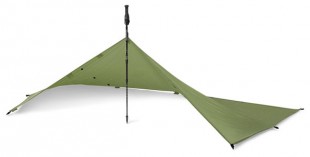
- Tarps and bashas: Beloved of survivalists and the military, a big sheet of fabric with eyelets round the edge (and sometimes in the centre for suspending from overhanging trees) is used for improvising camp. As light as a bivi and – when well used – as spacious as a tent, they doubtless have their plus points. The idea is to find a couple of trees, tie a line between them and drape your tarp over the top, then secure the corners and sides down to form an old-fashioned ridge tent. Finding ingenious little variations on the basic technique to suit the landscape you find yourself in can be very satisfying…or laborious and frustrating.
Like hammocks, they rely on the natural world to provide the fixtures and fittings, so like hammocks, they’re not as versatile as something self contained like a tent or a bivi bag. They don’t keep midges out either!
So that’s shelter. Basically, take a small, compact tent, unless the upsides of the alternatives are at the top of your priority list.

Sleeping Bag & Mat
Sleeping Bag: We don’t really intend to deal with how warm a bag to get, as that’s down to how cold the weather is, not how far you are from a campsite! Lets just say that probably the most ‘general purpose’ of bags is something rated with a “Comfort Lower Limit” of around -5°C, or “3 Season” if you’re using old money.
Again, not really an argument specific to wild camping, but let’s go through the basics. The main choice is down or synthetic fill. Down is more efficient, hence you need less of it in the bag to keep you warm, hence down filled bags are lighter and pack away smaller. A good thing. Ever seen a feather that’s got wet though? All that soft fluff around the bottom of the stalk collapses into a damp mess. Then when it dries again, it’s a hard, crispy lump. A bad thing.
Synthetic fill is generally cheaper and insulates much better when it gets wet, then when it dries out it’s OK again…but it’s heavier, bulkier, and actually, it doesn’t last as long as down before it breaks down and the bag is past its best.
In a decent tent, on a pitch that hasn’t got a watercourse tricking through it, there’s no good reason for your sleeping bag to get problematically wet – provided it’s also well wrapped when it’s in your rucksack! In a more open arrangement such as sleeping under a tarp, there’s obviously more risk of sogginess.
So, if there’s a significant risk of drenching the bag, down’s a bad idea and you should consider synthetic. If there isn’t, and if you can afford it, down’s a good idea.
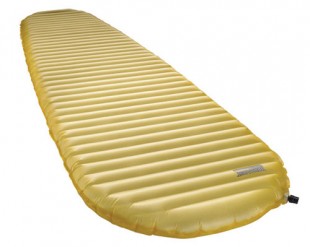
- Mats: Don’t kid yourself into thinking you can save weight and get by without taking one! You’ll get cold, you’ll be uncomfortable, you won’t sleep. There are foam roll mats; there are loads of different self inflating mats. Foam mats are OK: they’re cheap, they’re light, but they’re a bit bulky and they’re not generally as comfortable as self-inflating mats.
Self inflating mats are foam mats, but it’s a spongy, springy, open foam encapsulated in an airtight fabric coating, with a valve on the end. Undo the valve so air can rush in, the sponge puffs up, close the valve again, lie down. Simple. As you climb the pricing ladder, you’ll find they get lighter (and sometimes tougher) and pack smaller, as fancier materials are used. There are different lengths and thicknesses available, and some people will opt for a skinny, three-quarter length one to save weight, while some will want to add an extra half inch of thickness and go for full length. How comfortable you will find them is up to you. Lie down on a few in an outdoor shop and see what you think, but be honest with yourself! Get one which you genuinely believe will be comfortable, or you won’t enjoy using it.
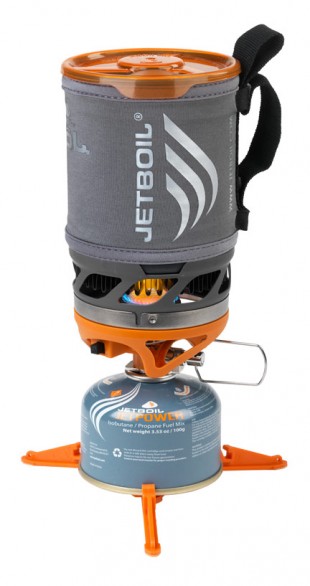
Stoves & Cookware
As mentioned, there’s a powerful “be discreet and leave no trace” ethic inherent in wild camping. This extends to cooking, which rules out chopping down trees to build campfires and leaving behind smouldering circles of scorched earth!
So, you’ll be needing a stove. At risk of sounding like a stuck record, this wants to be small and light! Little burners that screw straight onto the top of gas cartridges take up hardly any space and weigh next to nothing. Their principle disadvantage is that being on top of the canister, the centre of gravity of any pot placed on them is pretty high and therefore not that stable. Be careful though (and/or get a canister stabilising base) and you should be OK. They tend to be nice and cheap too.
Very related to this is the JetBoil, which could well be the ideal wild camping stove. This is also a canister mounted burner, but with an insulated cup/cooking pot that has a heat exchanger base for greater fuel efficiency. The pot clamps onto the burner to create one integrated fuel/burner/pan/mug assembly. When you’re finished cooking, the fuel and burner fit inside the pot. A protective cap for the base doubles as a bowl! Neat and simple, it’s won a lot of converts.
There are gas stoves which sit lower to the ground and connect to the gas via a hose so they’re more stable, but more structure means more weight and more bulk: probably not what you’re after.
If you’re out for quite a while, carrying enough gas to be self-contained becomes prohibitively heavy and bulky, and this makes liquid fuel stoves an avenue worth exploring. Not necessarily the pressurized type, which tend to be pretty weighty with their pump assemblies and separate burner units, but the unpressurized ones, the Trangia being the archetype.
Essentially just a little pot of alcohol with a flame dancing above it, the Trangia has the advantage of having no pressure valves, no pump assembly, no extra bits to go wrong. Great if you’re miles away from a backup option! The lack of a fierce flame means it takes a while to heat anything up, but that’s not the end of the world. It comes as a cook kit, with the burner, windshield and various different combinations of pans and kettles: it should be obvious if you’ve read this far that I’m going to recommend you choose a small, basic variant!
There’s growing interest in stoves which burn fuel you can find lying around the place – dead twigs, bark, even dried animal dung. These are like little contained campfires, so they run the risk of burning the ground but, if you’re careful, they could be a good option. The Wild Woodgas stove, for example, looks like a nest of pastry cutters but, when slotted together forms a small chamber in which to light a fire and through a nicely thought out series of vents, uses its own rising heat to move the air inside it to fan its own flames. Common sense says that if you’re using one of these, you’re relying on being able to find fuel lying around, which is maybe a bit risky. If you’re going for this type of stove, maybe take some hexamine solid fuel tablets or the burner cup from a Trangia as backup, just in case.
If you’re not taking a cook-kit which comes with pans, take a small pan. Obviously. Just the one is plenty. If you’re getting really obsessive about keeping the weight down, you can go for titanium, but you’ll pay a pretty penny for it and aluminium is fine! You can eat directly from it (take a spoon, fork or “spork”), but drinking straight from it is probably taking things a bit far. Take a plastic or metal mug too.
Food & Drink
Let’s assume we’re talking camping-specific sustenance, shall we?! There are two basic categories: “wet” food and dehydrated food. Wet food is like the sort of food you get in tins, ready cooked, OK to eat cold if something goes wrong with your stove, but it tends to be very long dated and comes in pouches so it’s lighter than a tin would be. It’s frequently “boil-in-the-bag” too, so you can heat it in a pan of water which you also use to make a brew. This sort of meal is sometimes available in a self-heating variant: you trigger a chemical reaction in a poly bag which gives out heat, then you pop your pouch of food in the bag and it warms up. This dispenses with the need for a stove, and in fact, you can now get a “flameless cooking system”, which is basically the same thing but you sit the whole lot in a reusable tub and just buy replacement chemical heat packs.
Dried food is lighter of course, but if you’re having to take along water to rehydrate it, the weight evens out. If you know there’s a decent water source where you’re going though, dehydrated food makes a lot of sense.
Regarding water sources: you never quite know what’s in water that you find in streams and ponds. Clear and running water is safer to drink than still, and you might be fine…but if you’re erring on the side of caution, there are ways to treat water to render it safe. Boiling deals with most things, but is fuel intensive. You could take a filter, purifier or SteriPen UV treatment system and, litre for litre, this works out as quite a cost effective thing to do, if you use it a lot. They can be heavy and fairly pricey as an initial outlay though, so if you head out in the wilderness from time to time and you want to treat water, a small pack of Chlorine or Chlorine Dioxide tablets/droplets is easy to use, is pretty cheap, will treat more water than you’re likely to use in a week and causes about as much impact on your rucksack as a packet of Tic Tacs.
A word about Chlorine. It works, but it tastes like swimming with your mouth open in a public pool. Neutralising tablets are available which take away the taste.
Clothing
Simple really: the usual going-out-walking-in-the-hills clothing. Avoid stuff which takes a long time to dry, and as well as waterproofs, make sure you’ve got a warm jacket with you. You will quite possibly be sitting around for quite a while in the evenings, and this can mean getting cold. Even if you don’t get dangerously cold, you don’t want to be miserably cold!
How many changes you take with you is up to you and partly dictated by the length of your trip. Merino wool is famously non-stink even after protracted amounts of use, and various other technical fabrics are now treated with silver or other antimicrobial finishes to avoid the pong of constant wear and infrequent change, so you can probably get away with a very minimal wardrobe.
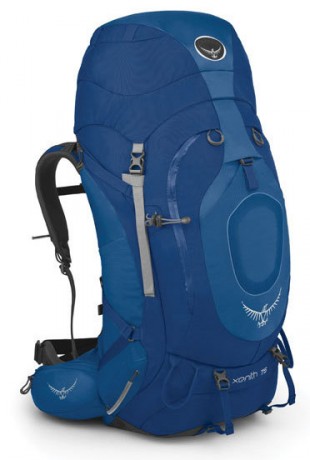
Rucksack
There are lots of fancy bits adorning rucksacks these days but none of them are the be-all and end-all. To be honest, as long as it fits all the stuff we’re discussing and is comfortable to carry, then that’s the right bag to take. If you’re sensible with your choice of gear, you’ll get a complete overnight kit into a 40-odd litre pack. Smaller is certainly possible, but requires either a minimalist approach to shelter or very great care (and most likely great expenditure) when selecting tents, sleeping bags and mats. Longer trips will probably need a bigger bag – more like 60 litres or so – for extra food and fuel.
Other Stuff
To start with, there’s the “outdoorsy” stuff. Penknife, first aid kit, headtorch. Make sure you’ve got a headtorch! You’ll need to see what you’re doing, and you’ll need to be able to do it: hands free lighting is essential. Obviously you need sufficient batteries, but it’s worth also considering a backup torch too (something tiny like a Petzl eLite).
Useful odds and sods. A few utility bits and pieces for effecting repairs to things and overcoming little difficulties you encounter. A fairish amount of 2mm climbing accessory cord or paracord is essential if you’re using a tarp, but a good idea in any event. If you need to extend or replace a guy rope on your tent, then you’ll be annoyed if you have to use your bootlaces. Along with gaffer tape and a small bundle of cable ties, this should be enough to sort most things.
Midges. Biting demons, hell bent on tormenting campers. You can take steps to avoid midge-ridden areas, but this unfortunately means avoiding calm, shady spots: in other words, not camping in the places which look most inviting! If it’s breezy and open, they shouldn’t be too much bother, but you never know exactly where you’ll end up. For all the minimalist ethos of wild camping, it pays to be prepared for midges. Take a head net, take a bottle of DEET, consider taking mozzie coils…and maybe take up smoking a pipe.
Toiletries. You’re not checking into a health spa, you’re getting back to nature…but basic hygiene needs to be serviced. Toothbrush, wet wipes and/or drywash and bog roll should be sufficient.
Luxuries! If you’ve been good about keeping the weight down, you should be able to allow yourself a treat or two. Some decent chocolate is always a favourite, or if coffee’s your thing, you could take a metal or plastic cafétière. In fact, JetBoil do a coffee plunger to add to their cooking system, converting the mug/cooking pot into a cafétière for a very small weight penalty. Maybe a hip-flask? A chair kit for your sleeping mat doesn’t weight a huge amount but adds an astonishing feeling of opulence to an otherwise very basic camping setup. Don’t go mad, but do enjoy yourself!